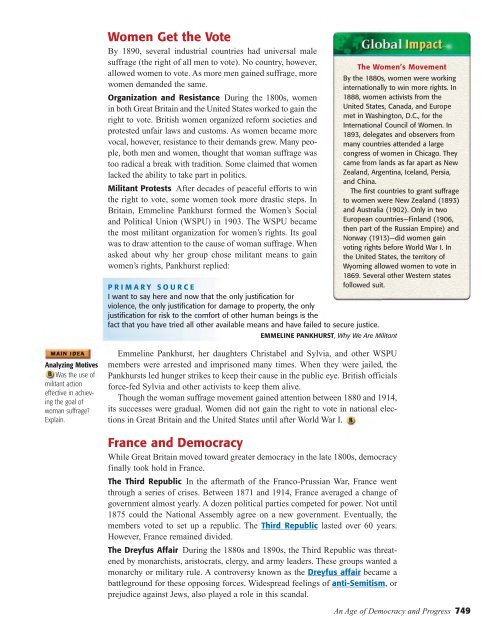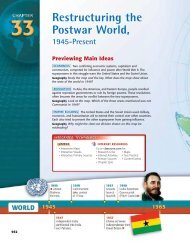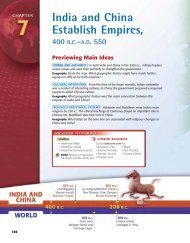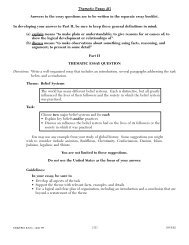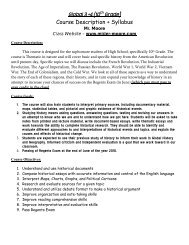The Industrial Revolution, 1700– 1900 Previewing Main Ideas
The Industrial Revolution, 1700– 1900 Previewing Main Ideas
The Industrial Revolution, 1700– 1900 Previewing Main Ideas
You also want an ePaper? Increase the reach of your titles
YUMPU automatically turns print PDFs into web optimized ePapers that Google loves.
Analyzing Motives<br />
Was the use of<br />
militant action<br />
effective in achieving<br />
the goal of<br />
woman suffrage?<br />
Explain.<br />
Women Get the Vote<br />
By 1890, several industrial countries had universal male<br />
suffrage (the right of all men to vote). No country, however,<br />
allowed women to vote. As more men gained suffrage, more<br />
women demanded the same.<br />
Organization and Resistance During the 1800s, women<br />
in both Great Britain and the United States worked to gain the<br />
right to vote. British women organized reform societies and<br />
protested unfair laws and customs. As women became more<br />
vocal, however, resistance to their demands grew. Many people,<br />
both men and women, thought that woman suffrage was<br />
too radical a break with tradition. Some claimed that women<br />
lacked the ability to take part in politics.<br />
Militant Protests After decades of peaceful efforts to win<br />
the right to vote, some women took more drastic steps. In<br />
Britain, Emmeline Pankhurst formed the Women’s Social<br />
and Political Union (WSPU) in 1903. <strong>The</strong> WSPU became<br />
the most militant organization for women’s rights. Its goal<br />
was to draw attention to the cause of woman suffrage. When<br />
asked about why her group chose militant means to gain<br />
women’s rights, Pankhurst replied:<br />
PRIMARY SOURCE<br />
I want to say here and now that the only justification for<br />
violence, the only justification for damage to property, the only<br />
justification for risk to the comfort of other human beings is the<br />
fact that you have tried all other available means and have failed to secure justice.<br />
EMMELINE PANKHURST, Why We Are Militant<br />
Emmeline Pankhurst, her daughters Christabel and Sylvia, and other WSPU<br />
members were arrested and imprisoned many times. When they were jailed, the<br />
Pankhursts led hunger strikes to keep their cause in the public eye. British officials<br />
force-fed Sylvia and other activists to keep them alive.<br />
Though the woman suffrage movement gained attention between 1880 and 1914,<br />
its successes were gradual. Women did not gain the right to vote in national elections<br />
in Great Britain and the United States until after World War I.<br />
France and Democracy<br />
While Great Britain moved toward greater democracy in the late 1800s, democracy<br />
finally took hold in France.<br />
<strong>The</strong> Third Republic In the aftermath of the Franco-Prussian War, France went<br />
through a series of crises. Between 1871 and 1914, France averaged a change of<br />
government almost yearly. A dozen political parties competed for power. Not until<br />
1875 could the National Assembly agree on a new government. Eventually, the<br />
members voted to set up a republic. <strong>The</strong> Third Republic lasted over 60 years.<br />
However, France remained divided.<br />
<strong>The</strong> Dreyfus Affair During the 1880s and 1890s, the Third Republic was threatened<br />
by monarchists, aristocrats, clergy, and army leaders. <strong>The</strong>se groups wanted a<br />
monarchy or military rule. A controversy known as the Dreyfus affair became a<br />
battleground for these opposing forces. Widespread feelings of anti-Semitism, or<br />
prejudice against Jews, also played a role in this scandal.<br />
<strong>The</strong> Women’s Movement<br />
By the 1880s, women were working<br />
internationally to win more rights. In<br />
1888, women activists from the<br />
United States, Canada, and Europe<br />
met in Washington, D.C., for the<br />
International Council of Women. In<br />
1893, delegates and observers from<br />
many countries attended a large<br />
congress of women in Chicago. <strong>The</strong>y<br />
came from lands as far apart as New<br />
Zealand, Argentina, Iceland, Persia,<br />
and China.<br />
<strong>The</strong> first countries to grant suffrage<br />
to women were New Zealand (1893)<br />
and Australia (1902). Only in two<br />
European countries—Finland (1906,<br />
then part of the Russian Empire) and<br />
Norway (1913)—did women gain<br />
voting rights before World War I. In<br />
the United States, the territory of<br />
Wyoming allowed women to vote in<br />
1869. Several other Western states<br />
followed suit.<br />
An Age of Democracy and Progress 749


